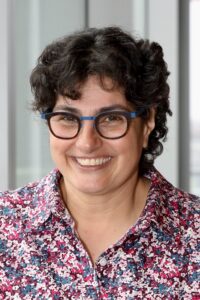Letter from the Dean

Photo by Allegra Boverman. School of Science Dean Nergis Mavalvala.
Hello, my dear fellow alumni and friends,
In this issue, we take an in-depth look at artificial intelligence through the lens of fundamental scientific research. At a place like MIT, it’s no surprise that we are global leaders in understanding how to both develop AI systems and use them in our research. What might be more surprising is that researchers in the School of Science, not just the MIT Schwarzman College of Computing or the School of Engineering, are leading the way. Here is a primer about what we mean when we, as scientists, use the term AI.
Those of you who joined our breakfast talk this past October were treated to a lecture by Professor Jesse Thaler about AI and physics. Jesse is a theoretical particle physicist who fuses techniques from quantum field theory and machine learning to address outstanding questions in fundamental physics. His research is focused on maximizing the discovery potential of the Large Hadron Collider (LHC) through novel theoretical frameworks and data analysis techniques. He is an expert in jets, which are collimated sprays of particles that are copiously produced in particle collisions at the LHC.
In addition, Jesse is the inaugural director of the Institute for Artificial Intelligence and Fundamental Interactions (IAIFI), which is housed within our Laboratory for Nuclear Science. Supported by a grant from the National Science Foundation, IAIFI is the intellectual home of more than 25 physics and AI senior researchers at MIT, Harvard, Northeastern, and Tufts universities. Read more about how Jesse became a convert to AI in physics research.
Next, you’ll read about IAIFI postdoc fellow Jessie Micallef who uses advanced machine learning techniques and foundational particle physics theory in their work to better understand “ghost particles” or neutrinos. We have based our own School of Science postdoc fellowship on IAIFI’s prestigious program with the goal of attracting and retaining the best talent among researchers who see scientific pursuits as inherently interdisciplinary.
Interdisciplinarity is the heart of Professor Kaiming He’s vision for the future. The College of Computing hired He to sit at the intersection of science, computing, AI, and engineering. This is what the College allows MIT to do—to bring computation to every aspect of the research we undertake here: from expansive questions about the universe’s formation to applied questions about protein folding and therapeutics.
You can read about Professor Danna Freedman’s work, sponsored by the U.S. Department of Energy, using an AI model to help reveal the structure of different materials. By analyzing X-ray crystallography data, the model could help researchers develop new materials for many applications, including batteries and magnets.
And lest you think the entire issue is about AI, learn more about how our climate science efforts are proceeding. Read an interview with Professor Ronald Prinn, a longtime leader in the field of climate science who has just handed the torch to Professor Noelle Selin to lead MIT’s endeavors. Noelle and researchers at the Center for Sustainability Science and Strategy, housed within the School of Science, will work hand in glove with the MIT Climate Project to ensure that science is the basis for progress, and equity is the goal for implementation.
Also newly at the helm of MIT’s efforts in translational research is Alex Shalek, director of the Institute for Medical Engineering and Science. Alex and others in his orbits—including MIT’s Koch Institute for Integrative Cancer Research; the Ragon Institute of Mass General, MIT, and Harvard; the Broad Institute of MIT and Harvard; Mass General Brigham; and Harvard Medical School—will be critical players in our newly launched collaborative focused on life sciences.
MIT’s Health and Life Sciences Collaborative is based on the work of a report Dean Anantha Chandrakasan and I commissioned called the Vision to Integrate, Translate, and Advance the Life Sciences (VITALS). Last month saw the launch of this exciting new MIT collaborative that will provide a basis for engagement with hospitals, biotech, and pharmaceutical companies — yes, in the Kendall Square Innovation Hub — but also beyond our Cambridge borders.
I hope some of you will join me in the spring for a breakfast talk focused on the next steps for this important collaborative. As always, I hope you will come to campus soon to celebrate these initiatives and achievements with us in person!
With my very best wishes,
Nergis Mavalvala, PhD ‘97